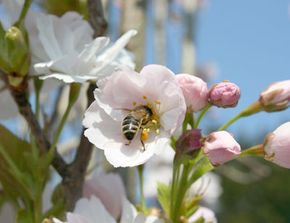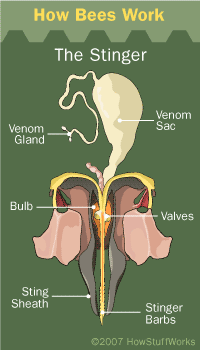Quck answer
Bees are important pollinators and play a vital role in our ecosystem. They collect nectar from flowers and turn it into honey, which they store in their hives. Bees communicate with each other through dances and work together to maintain their hive. The queen bee lays eggs, while worker bees take care of the young and gather food. Bees also have a complex social hierarchy and use pheromones to communicate. Unfortunately, bees are facing threats from habitat loss, pesticides, and disease. It is important to protect them and their habitats to ensure their survival and the health of our environment.
Wildlife Creatures
The Legs and Stingers of Bees

The hind legs of bees have baskets made of hair that are filled with pollen.
Image courtesy MorgueFile
The legs of bees have five basic parts – coxa, trochanter, femur, tibia, and tarsus. These parts function like the hip, thigh, shin, and foot of a bee. The segments are separated by tiny joints. Bees have specialized structures on their legs such as brush, comb, and basket-like hairs for collecting pollen, a pad and claw for holding and manipulating objects, a small groove for removing pollen from the antenna, and a press for packing pollen.
- The abdomen of bees has almost no appendages, but it contains most of the bee’s internal organs. Spiracles allow bees to breathe, and tubes and tracheae carry oxygen into their bodies. The hemolymph, which is the blood of bees, is pumped through an aorta located in the thorax, and it is colorless due to the absence of red blood cells. The crop or honey stomach in the digestive system of bees is located in their abdomen, where they hold nectar.

The stinger is the only notable appendage found in the abdomen of bees. It is a modified ovipositor or egg depositor that delivers venom produced by the bee’s venom gland. Bees inherited their venom from their wasp-like ancestors who used their ovipositors to lay their eggs in the bodies of other insects. Over time, the substances that coated the ovipositor became venomous, which made it easier for prehistoric wasps to subdue prey. While some bees do not have stingers, others have barbed stingers that stick in the bodies of mammals, causing the bee to die. Queen honeybees and many other species of bees have smooth stingers that can sting mammals repeatedly.
Bee’s venom contains peptides and enzymes that destroy cells by breaking through and destroying the layer of fats lining each cell. The venom also destroys the mast cells in the skin, which are part of the body’s immune system. This stimulates histamine production, which dilates blood vessels and allows immune cells to reach the sting site faster and neutralize the venom.
Bees produce a range of useful substances in glands found throughout their bodies. The types of glands and substances produced vary depending on the species of bee and how it lives.
When individuals with bee sting allergies are stung, their bodies release an excessive amount of histamine, causing the blood vessels to dilate excessively. This impairs their ability to regulate blood pressure, leading to a rapid drop in blood pressure and a lack of oxygen delivery to cells. Anaphylactic shock of this type also causes swelling and spasms, which can result in death. The usual treatment for this condition is an injection of epinephrine, which constricts blood vessels, restoring blood pressure and oxygen delivery.
FAQ
1. What are bees and why are they important?
Bees are insects that are known for their ability to pollinate plants. They play a crucial role in ecosystems around the world, as they are responsible for pollinating many of the foods we eat, including fruits, vegetables, and nuts. Without bees, our food supply would be greatly diminished.
2. How do bees pollinate plants?
Bees pollinate plants by transferring pollen from the male parts of a flower to the female parts of another flower. As they collect nectar, they inadvertently pick up pollen on their bodies, which is then transferred to the next flower they visit.
3. What is a bee colony?
A bee colony is a group of bees that live and work together in a hive. It typically consists of a queen bee, drones, and worker bees.
4. What is the role of the queen bee?
The queen bee is responsible for laying eggs and maintaining the cohesion of the colony. She also releases pheromones that help keep the bees in the colony working together.
5. What are the roles of drones?
Drones are male bees whose main purpose is to mate with the queen bee. They do not have stingers and do not gather nectar or pollen like worker bees.
6. What are the roles of worker bees?
Worker bees are female bees whose roles include gathering nectar and pollen, caring for the queen and developing brood, cleaning and maintaining the hive, and defending the colony.
7. How do bees communicate with each other?
Bees communicate with each other through a series of dances and pheromone release. They are able to convey the location of food sources and communicate about potential threats to the colony.
8. What is honey and how is it made?
Honey is a sweet, sticky substance that bees make from nectar. Bees collect nectar from flowers and store it in their honey stomachs, where it mixes with enzymes to create honey. The bees then regurgitate the honey into the honeycomb, where it is stored and eventually capped with wax.
9. What is beeswax and how is it made?
Beeswax is a natural wax produced by worker bees. They secrete it from glands on their bodies and use it to build the honeycomb that stores honey and brood.
10. What is propolis and how is it used?
Propolis is a sticky substance that bees make from tree resin. They use it to seal cracks and gaps in the hive and to sterilize the hive environment. Propolis has antimicrobial and anti-inflammatory properties and is used in some natural remedies.
11. Why are bees in danger?
Bees are in danger due to a combination of factors, including habitat loss, pesticide use, climate change, and disease. These factors have caused declines in bee populations around the world, which could have serious consequences for ecosystems and agriculture.
12. What can we do to help bees?
There are many things we can do to help bees, including planting bee-friendly flowers, reducing pesticide use, supporting local beekeepers, and advocating for policies that protect bees and their habitats. By taking action to protect bees, we can help ensure that they continue to play an important role in our ecosystems and food supply.





Leave a Reply